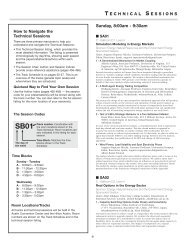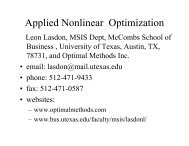Sunday
Sunday
Sunday
You also want an ePaper? Increase the reach of your titles
YUMPU automatically turns print PDFs into web optimized ePapers that Google loves.
SA68<br />
4 - Detection of Approximate Periodicity in Categorical Time Series<br />
with Time Intervals<br />
Jian Liu, Assistant Professor, The University of Arizona, Rm 221<br />
ENGR Building, 1127 E. James E. Rogers Way, Tucson, AZ, 85721,<br />
United States of America, jianliu@sie.arizona.edu, Zhenrui Wang,<br />
Mingyang Li, Sean Dessureault<br />
Categorical time series are symbol sequences arranged in the order of occurrence.<br />
When time of occurrences of symbols is also available, order and time<br />
information should be fused to detect periodic patterns. In practice, symbols often<br />
repeat with only approximately equal time intervals. This paper employs<br />
statistical method for the detection of such approximate periodicity. A case study<br />
from mining industry demonstrates the effectiveness of the proposed approach.<br />
5 - Modeling, Experimental Design, and Analysis of<br />
Stereolithography Process for Direct 3-D Printing<br />
Jizhe Zhang, University of Southern California, 3715 McClintock<br />
Avenue, GER 240, Los Angeles, CA, 90089, United States of<br />
America, jizhezha@usc.edu, Qiang Huang, Arman Sabbaghi,<br />
Tirthankar Dasgupta<br />
We propose a systematic model to model and predict the shrinkage process to<br />
address the accuracy problem for Stereolithography (SLA, one technique for 3-D<br />
printing), instead of the traditional finite element simulation or experimental<br />
trial-and-error methods. A variant of Latin Square experimental design is<br />
employed to identify the process model and the experimental outcomes are<br />
analyzed for optimized compensation. One case study is presented to verify the<br />
shrinkage model and compensation.<br />
■ SA68<br />
68- Suite 312- Hyatt<br />
Finance: Portfolio Analysis<br />
Contributed Session<br />
Chair: Ludovic Cales, HEC - University of Lausanne, Bat. Extranef,<br />
Room 253, Lausanne, 1015, Switzerland, ludovic.cales@unil.ch<br />
1 - Absolute Return Portfolios<br />
John Beasley, Brunel University & JB Consultants,<br />
United Kingdom, john.beasley@brunel.ac.uk<br />
We consider the problem of deciding an absolute return portfolio, a portfolio of<br />
assets that is designed to deliver a constant return over time. We present a threestage<br />
mixed-integer zero-one program for the problem that explicitly considers<br />
transaction costs associated with trading. We extend our approach to the problem<br />
of designing portfolios with differing characteristics. Computational results are<br />
given for portfolios derived from universes defined by S&P international equity<br />
indices.<br />
2 - A New Approach to Asset Allocation: Constructing Portfolio<br />
Holdings Directly<br />
Nan Xiong, Carnegie Mellon University, Tepper School of Business,<br />
5000 Forbes Avenue, Pittsburgh, PA, United States of America,<br />
nxiong@andrew.cmu.edu, Javier Peña, Burton Hollifield<br />
In this paper, we propose a new approach to portfolio construction, which<br />
incorporates the estimation and optimization into a one-stage problem. We<br />
propose a new portfolio allocation strategy based on our one-stage formulation.<br />
We show that the resulting portfolio weights are less sensitive to the noisy data.<br />
Moreover, the proposed portfolio tends to perform better out-of-sample. The<br />
numerical results based on empirical and simulated data confirm our findings.<br />
3 - Interactive Portfolio Optimization using Mean-Gini Criteria<br />
Ran Ji, PhD Student, George Washington University, 2201 G St.,<br />
Funger Hall 415H, Washington DC, DC, 20052, United States of<br />
America, jiran@gwu.edu, Miguel Lejeune, Srinivas Prasad<br />
We propose a bi-objective Mean-Gini portfolio optimization model. An interactive<br />
solution procedure is designed to elicit preferences among the efficient portfolios.<br />
Computational results describing the convergence of the interactive procedure<br />
and the out-of-sample performance of the portfolios will be presented.<br />
4 - A Bi-objective Portfolio Model for Supporting Services<br />
in a Hospital<br />
Bartosz Sawik, PhD, Department of Applied Computer Science,<br />
Faculty of Management, AGH University of Science and<br />
Technology, Al. Mickiewicza 30, Krakow, 30059, Poland,<br />
B_Sawik@yahoo.com<br />
This paper presents a bi-objective portfolio model for optimal allocation of<br />
supporting services in a hospital. The services include inventory, financial,<br />
operations management, etc. The optimality criteria of the problem are<br />
minimization of operational costs of supporting services subject to some specific<br />
constraints. The constraints represent specific conditions for resource allocation in<br />
a hospital. The computational experiments based on a real data from a hospital in<br />
Poland.<br />
INFORMS Phoenix – 2012<br />
78<br />
5 - A Rank-based Approach to Cross-sectional Analysis<br />
Ludovic Cales, HEC-University of Lausanne, Bat. Extranef,<br />
Room 253, Lausanne, 1015, Switzerland, ludovic.cales@unil.ch,<br />
Monica Billio, Dominique Guègan<br />
This paper studies the cross-sectional effects present in the market using a new<br />
graph theoretic framework. We model the evolution of a dynamic portfolio, i.e. a<br />
portfolio whose weights change over time, as a function of cross-sectional factors<br />
where the predictive ability of each factor is described by a variable. This<br />
modeling permits us to measure the marginal and joint effects of different crosssection<br />
factors on a given dynamic portfolio. Applications are presented.<br />
■ SA69<br />
69- Suite 314- Hyatt<br />
Finance: Banking and Insurance<br />
Contributed Session<br />
Chair: Komlan Sedzro, Professor, School of Management, University of<br />
Quebec, 315 Ste Catherine Est, succ. Centre-Ville, Montreal, QC,<br />
H3C3P8, Canada, sedzro.k@uqam.ca<br />
1 - Loan Rate Optimization for Financing Platforms<br />
Wei Wang, IBM Research-China, Building 19 Zhongguancun<br />
Software Park, Haidian District, Beijing, 100193, China,<br />
Wangwcrl@cn.ibm.com, Yueting Chai, Hongwei Ding, Jin Dong<br />
Financing platform is an important channel for small and medium enterprises<br />
(SME) to get loan supports. When receiving a loan request from a client, the<br />
financing platform needs to made decision on the loan rate. We build an<br />
optimization model for decision support. The objective is to maximize the profit<br />
and minimize the financing risks. A local-search based heuristics algorithm is<br />
designed to find the optimal solution; the simulation model is built to evaluate<br />
each option.<br />
2 - B-spline Method of Estimating Term Structure of Interest Rate<br />
Yifeng Yan, Xi’an Jiaotong University, No.2269 Mailbox, Xi’an,<br />
710049, China, yanyifeng0123@163.com, Ju’e Guo<br />
This study implements the B-spline method to estimate the term structure of<br />
interest rate using data in Shanghai stock exchange. It shows that the B-spline<br />
method has fine goodness of fitting.The B-spline method can be used as an<br />
effective tool of monitoring interest rate level and formulating monetary policies.<br />
3 - The Informational Advantage of Local Investors: Evidence from<br />
Fund Managers Trades<br />
Kian Ming Tan, Associate Lecturer, University of New South<br />
Wales, Kensington, Sydney, Australia, eric.tan@unsw.edu.au<br />
The economic value of geography for money managers is now well supported in<br />
the literature by evidence of the profitability of local investments. Using data on<br />
both mutual fund equity holdings and fund returns, we find stocks with higher<br />
local investor participation to be associated with stocks abnormal returns during<br />
post event period. In addition, local ownership seems to predict funds increasing<br />
weighting on affected firms which experience lower credit risk.<br />
4 - Finite Precision Errors in Stochastic Financial Networks<br />
Ganesh Perumal, International Institute of Information<br />
Technology, 26/C Electronics City, Bangalore, India,<br />
ganesh_perumal@iiitb.ac.in, Abhilasha Aswal,<br />
G. N. Srinivasa Prasanna<br />
A financial network of money transfers involving multiple currencies may be<br />
erroneous due to the usage of IEEE 754 binary standards. The fluctuations in<br />
currency exchange rates make this a random graph. In this presentation we show<br />
how to exploit such graphs to maximize cumulative errors in favour of some<br />
entity.<br />
5 - Comparing the Performance of Microfinance Institutions in<br />
South America and Asia<br />
Komlan Sedzro, Professor, School of Management, University of<br />
Quebec, 315 Ste Catherine Est, succ. Centre-Ville, Montréal, QC,<br />
H3C3P8, Canada, sedzro.k@uqam.ca, Marie-Héléne Noiseux<br />
We apply multi-directional efficiency analysis to compare the performance of<br />
microfinance institutions (MFIs) in South America and Asia. Indeed, despite their<br />
supposedly importance in combating financial exclusion, many MFIs find it hard<br />
to attain financial independence. This fact in itself justifies the importance of<br />
studies on the performance of MFIs, especially interregional comparisons. The<br />
objective is to see if the MFIs in one region can copy the good practices of another<br />
geographic area.



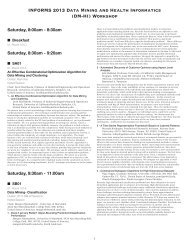
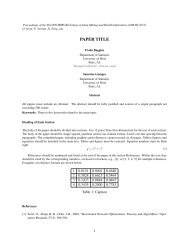
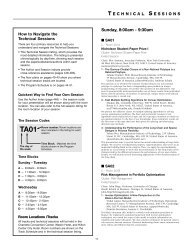
![[PDF] Charlotte Back Matter](https://img.yumpu.com/17933057/1/190x245/pdf-charlotte-back-matter.jpg?quality=85)

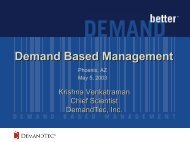
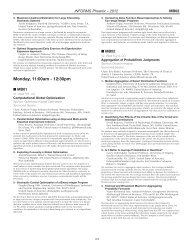
![[PDF] ALIO Back Matter](https://img.yumpu.com/17932960/1/190x245/pdf-alio-back-matter.jpg?quality=85)
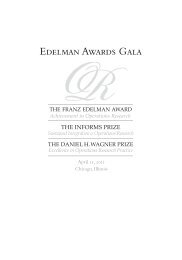
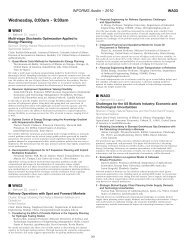
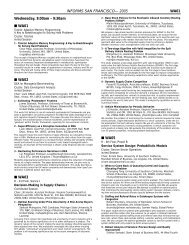
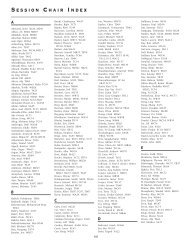
![[PDF] Monday, 8:00am - 9:30am](https://img.yumpu.com/17932954/1/190x245/pdf-monday-800am-930am.jpg?quality=85)
